A Textual Analysis of The God of Small Things PDF
VerifiedAdded on 2022/01/07
|8
|2271
|28
AI Summary
Contribute Materials
Your contribution can guide someone’s learning journey. Share your
documents today.
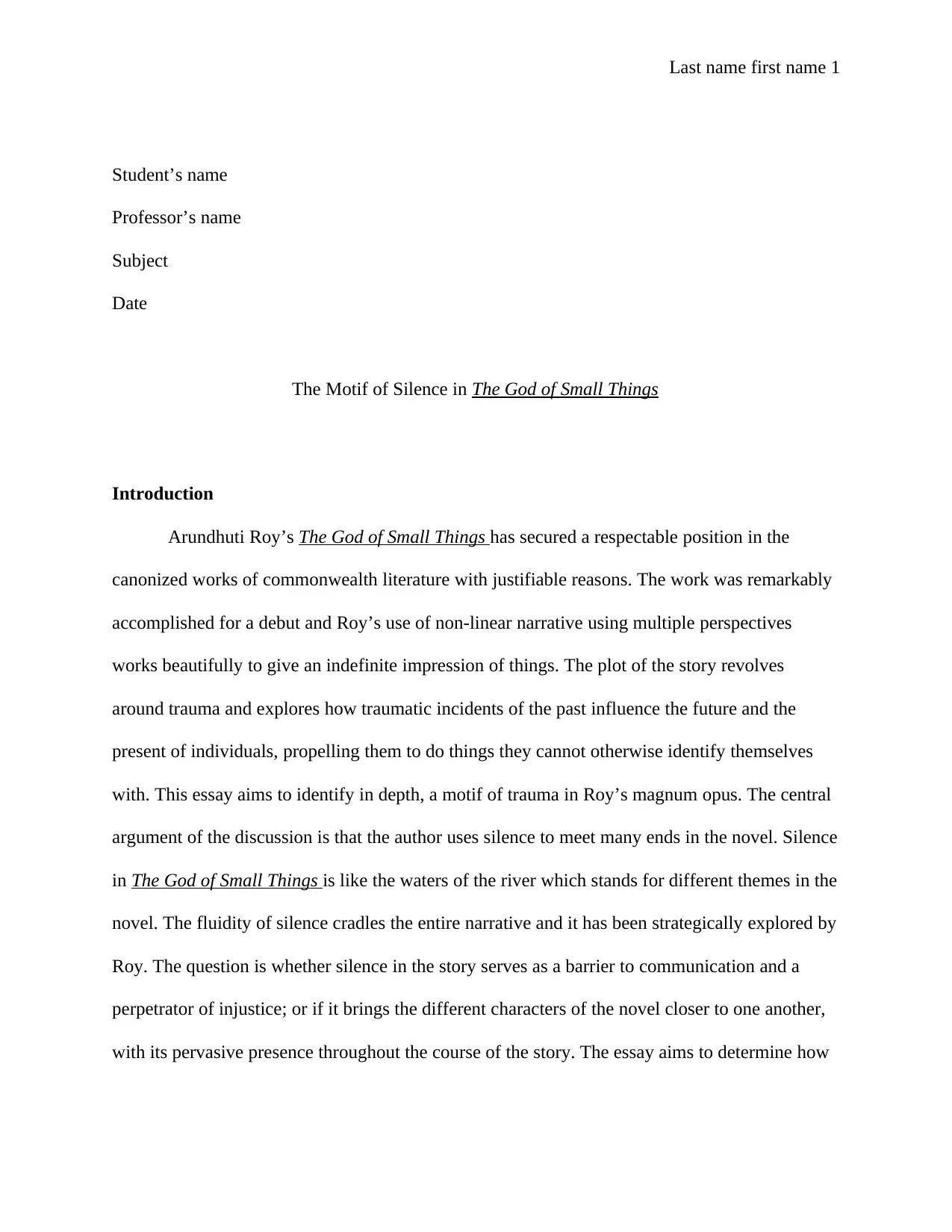
Last name first name 1
Student’s name
Professor’s name
Subject
Date
The Motif of Silence in The God of Small Things
Introduction
Arundhuti Roy’s The God of Small Things has secured a respectable position in the
canonized works of commonwealth literature with justifiable reasons. The work was remarkably
accomplished for a debut and Roy’s use of non-linear narrative using multiple perspectives
works beautifully to give an indefinite impression of things. The plot of the story revolves
around trauma and explores how traumatic incidents of the past influence the future and the
present of individuals, propelling them to do things they cannot otherwise identify themselves
with. This essay aims to identify in depth, a motif of trauma in Roy’s magnum opus. The central
argument of the discussion is that the author uses silence to meet many ends in the novel. Silence
in The God of Small Things is like the waters of the river which stands for different themes in the
novel. The fluidity of silence cradles the entire narrative and it has been strategically explored by
Roy. The question is whether silence in the story serves as a barrier to communication and a
perpetrator of injustice; or if it brings the different characters of the novel closer to one another,
with its pervasive presence throughout the course of the story. The essay aims to determine how
Student’s name
Professor’s name
Subject
Date
The Motif of Silence in The God of Small Things
Introduction
Arundhuti Roy’s The God of Small Things has secured a respectable position in the
canonized works of commonwealth literature with justifiable reasons. The work was remarkably
accomplished for a debut and Roy’s use of non-linear narrative using multiple perspectives
works beautifully to give an indefinite impression of things. The plot of the story revolves
around trauma and explores how traumatic incidents of the past influence the future and the
present of individuals, propelling them to do things they cannot otherwise identify themselves
with. This essay aims to identify in depth, a motif of trauma in Roy’s magnum opus. The central
argument of the discussion is that the author uses silence to meet many ends in the novel. Silence
in The God of Small Things is like the waters of the river which stands for different themes in the
novel. The fluidity of silence cradles the entire narrative and it has been strategically explored by
Roy. The question is whether silence in the story serves as a barrier to communication and a
perpetrator of injustice; or if it brings the different characters of the novel closer to one another,
with its pervasive presence throughout the course of the story. The essay aims to determine how
Secure Best Marks with AI Grader
Need help grading? Try our AI Grader for instant feedback on your assignments.
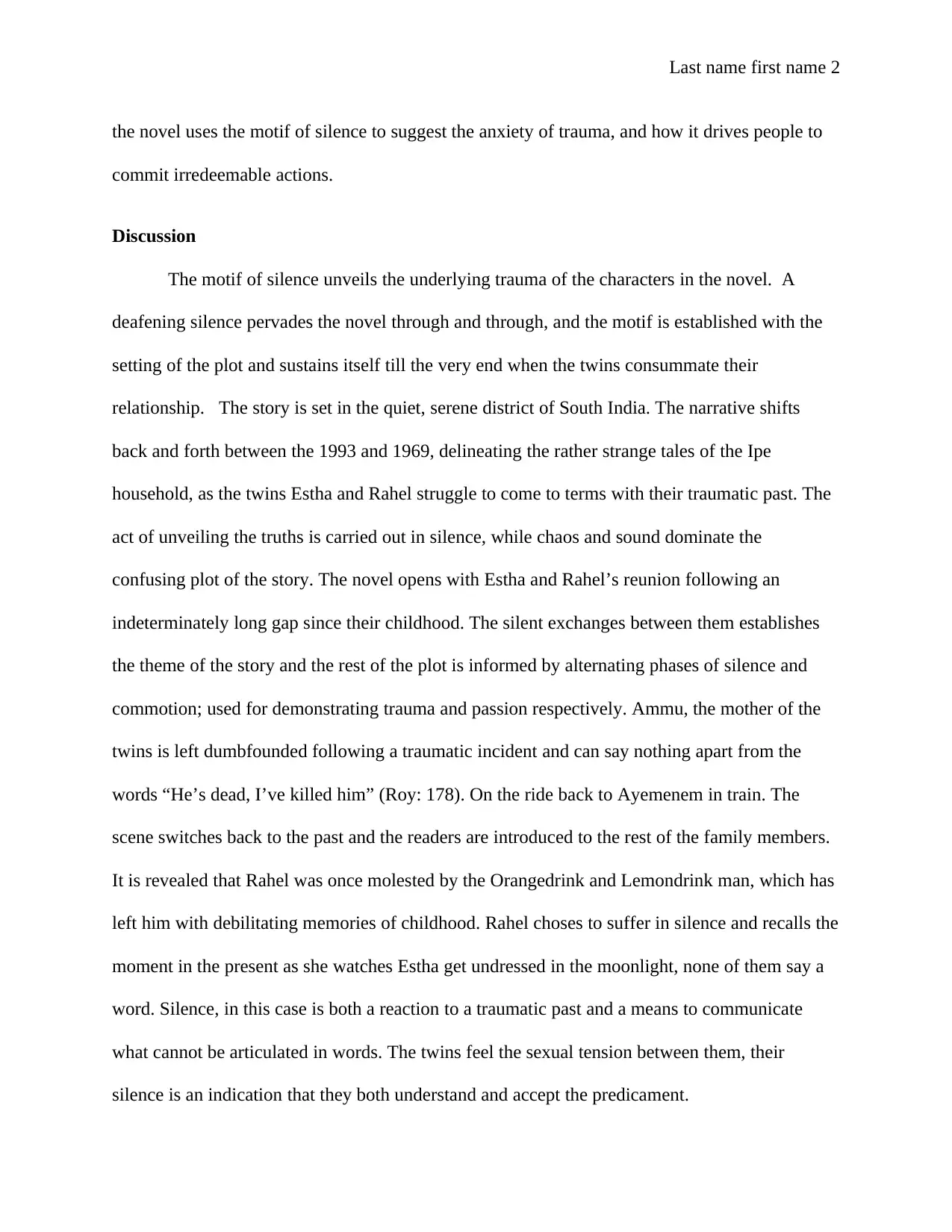
Last name first name 2
the novel uses the motif of silence to suggest the anxiety of trauma, and how it drives people to
commit irredeemable actions.
Discussion
The motif of silence unveils the underlying trauma of the characters in the novel. A
deafening silence pervades the novel through and through, and the motif is established with the
setting of the plot and sustains itself till the very end when the twins consummate their
relationship. The story is set in the quiet, serene district of South India. The narrative shifts
back and forth between the 1993 and 1969, delineating the rather strange tales of the Ipe
household, as the twins Estha and Rahel struggle to come to terms with their traumatic past. The
act of unveiling the truths is carried out in silence, while chaos and sound dominate the
confusing plot of the story. The novel opens with Estha and Rahel’s reunion following an
indeterminately long gap since their childhood. The silent exchanges between them establishes
the theme of the story and the rest of the plot is informed by alternating phases of silence and
commotion; used for demonstrating trauma and passion respectively. Ammu, the mother of the
twins is left dumbfounded following a traumatic incident and can say nothing apart from the
words “He’s dead, I’ve killed him” (Roy: 178). On the ride back to Ayemenem in train. The
scene switches back to the past and the readers are introduced to the rest of the family members.
It is revealed that Rahel was once molested by the Orangedrink and Lemondrink man, which has
left him with debilitating memories of childhood. Rahel choses to suffer in silence and recalls the
moment in the present as she watches Estha get undressed in the moonlight, none of them say a
word. Silence, in this case is both a reaction to a traumatic past and a means to communicate
what cannot be articulated in words. The twins feel the sexual tension between them, their
silence is an indication that they both understand and accept the predicament.
the novel uses the motif of silence to suggest the anxiety of trauma, and how it drives people to
commit irredeemable actions.
Discussion
The motif of silence unveils the underlying trauma of the characters in the novel. A
deafening silence pervades the novel through and through, and the motif is established with the
setting of the plot and sustains itself till the very end when the twins consummate their
relationship. The story is set in the quiet, serene district of South India. The narrative shifts
back and forth between the 1993 and 1969, delineating the rather strange tales of the Ipe
household, as the twins Estha and Rahel struggle to come to terms with their traumatic past. The
act of unveiling the truths is carried out in silence, while chaos and sound dominate the
confusing plot of the story. The novel opens with Estha and Rahel’s reunion following an
indeterminately long gap since their childhood. The silent exchanges between them establishes
the theme of the story and the rest of the plot is informed by alternating phases of silence and
commotion; used for demonstrating trauma and passion respectively. Ammu, the mother of the
twins is left dumbfounded following a traumatic incident and can say nothing apart from the
words “He’s dead, I’ve killed him” (Roy: 178). On the ride back to Ayemenem in train. The
scene switches back to the past and the readers are introduced to the rest of the family members.
It is revealed that Rahel was once molested by the Orangedrink and Lemondrink man, which has
left him with debilitating memories of childhood. Rahel choses to suffer in silence and recalls the
moment in the present as she watches Estha get undressed in the moonlight, none of them say a
word. Silence, in this case is both a reaction to a traumatic past and a means to communicate
what cannot be articulated in words. The twins feel the sexual tension between them, their
silence is an indication that they both understand and accept the predicament.
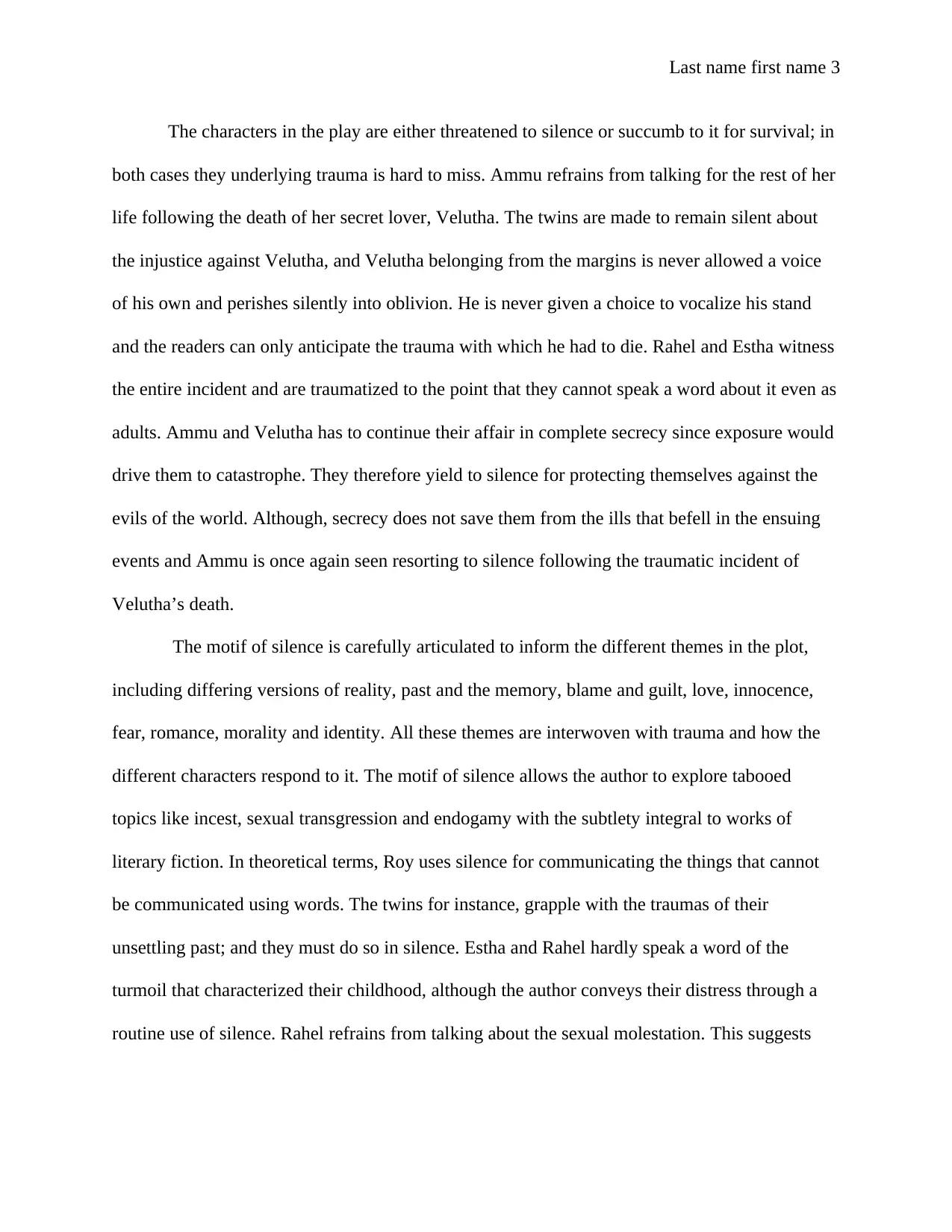
Last name first name 3
The characters in the play are either threatened to silence or succumb to it for survival; in
both cases they underlying trauma is hard to miss. Ammu refrains from talking for the rest of her
life following the death of her secret lover, Velutha. The twins are made to remain silent about
the injustice against Velutha, and Velutha belonging from the margins is never allowed a voice
of his own and perishes silently into oblivion. He is never given a choice to vocalize his stand
and the readers can only anticipate the trauma with which he had to die. Rahel and Estha witness
the entire incident and are traumatized to the point that they cannot speak a word about it even as
adults. Ammu and Velutha has to continue their affair in complete secrecy since exposure would
drive them to catastrophe. They therefore yield to silence for protecting themselves against the
evils of the world. Although, secrecy does not save them from the ills that befell in the ensuing
events and Ammu is once again seen resorting to silence following the traumatic incident of
Velutha’s death.
The motif of silence is carefully articulated to inform the different themes in the plot,
including differing versions of reality, past and the memory, blame and guilt, love, innocence,
fear, romance, morality and identity. All these themes are interwoven with trauma and how the
different characters respond to it. The motif of silence allows the author to explore tabooed
topics like incest, sexual transgression and endogamy with the subtlety integral to works of
literary fiction. In theoretical terms, Roy uses silence for communicating the things that cannot
be communicated using words. The twins for instance, grapple with the traumas of their
unsettling past; and they must do so in silence. Estha and Rahel hardly speak a word of the
turmoil that characterized their childhood, although the author conveys their distress through a
routine use of silence. Rahel refrains from talking about the sexual molestation. This suggests
The characters in the play are either threatened to silence or succumb to it for survival; in
both cases they underlying trauma is hard to miss. Ammu refrains from talking for the rest of her
life following the death of her secret lover, Velutha. The twins are made to remain silent about
the injustice against Velutha, and Velutha belonging from the margins is never allowed a voice
of his own and perishes silently into oblivion. He is never given a choice to vocalize his stand
and the readers can only anticipate the trauma with which he had to die. Rahel and Estha witness
the entire incident and are traumatized to the point that they cannot speak a word about it even as
adults. Ammu and Velutha has to continue their affair in complete secrecy since exposure would
drive them to catastrophe. They therefore yield to silence for protecting themselves against the
evils of the world. Although, secrecy does not save them from the ills that befell in the ensuing
events and Ammu is once again seen resorting to silence following the traumatic incident of
Velutha’s death.
The motif of silence is carefully articulated to inform the different themes in the plot,
including differing versions of reality, past and the memory, blame and guilt, love, innocence,
fear, romance, morality and identity. All these themes are interwoven with trauma and how the
different characters respond to it. The motif of silence allows the author to explore tabooed
topics like incest, sexual transgression and endogamy with the subtlety integral to works of
literary fiction. In theoretical terms, Roy uses silence for communicating the things that cannot
be communicated using words. The twins for instance, grapple with the traumas of their
unsettling past; and they must do so in silence. Estha and Rahel hardly speak a word of the
turmoil that characterized their childhood, although the author conveys their distress through a
routine use of silence. Rahel refrains from talking about the sexual molestation. This suggests
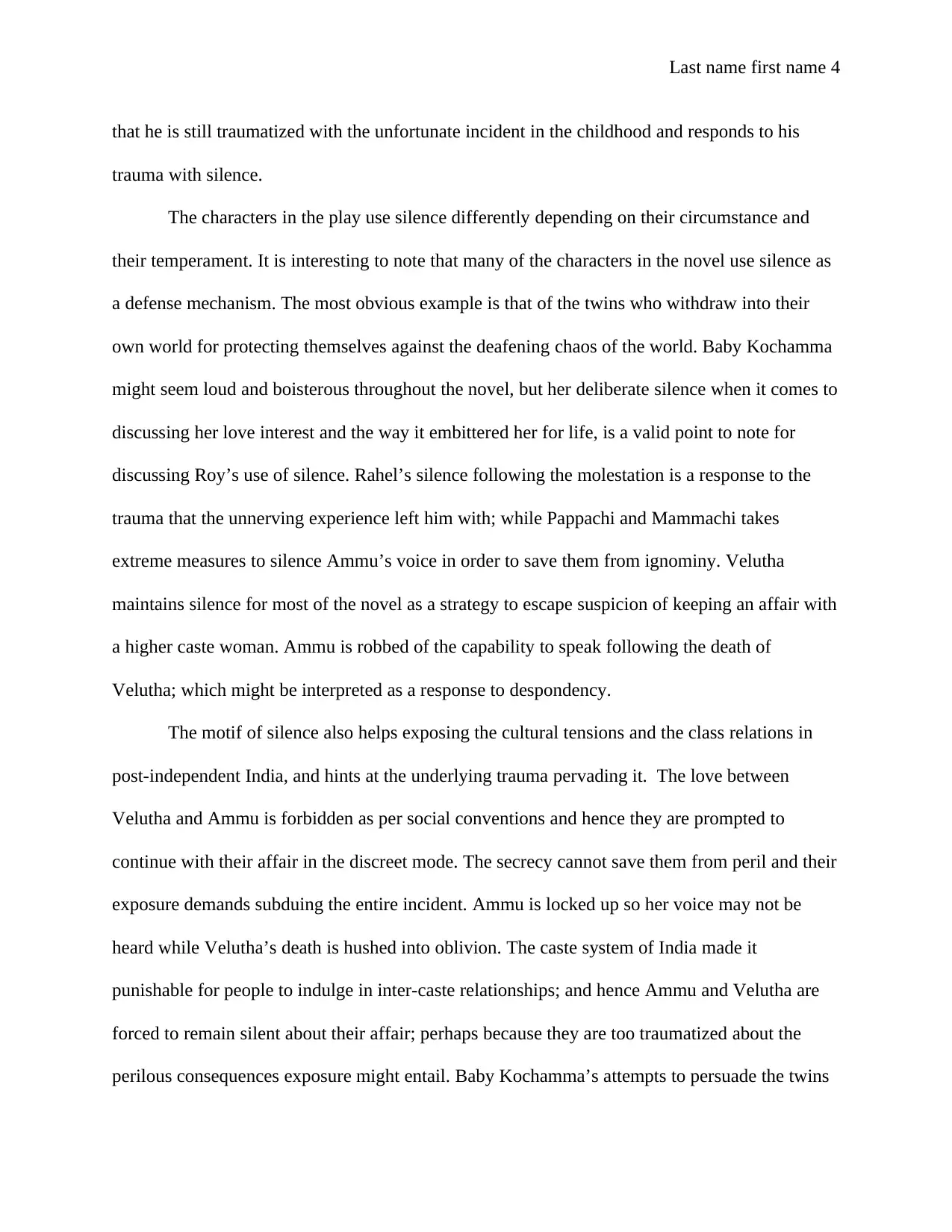
Last name first name 4
that he is still traumatized with the unfortunate incident in the childhood and responds to his
trauma with silence.
The characters in the play use silence differently depending on their circumstance and
their temperament. It is interesting to note that many of the characters in the novel use silence as
a defense mechanism. The most obvious example is that of the twins who withdraw into their
own world for protecting themselves against the deafening chaos of the world. Baby Kochamma
might seem loud and boisterous throughout the novel, but her deliberate silence when it comes to
discussing her love interest and the way it embittered her for life, is a valid point to note for
discussing Roy’s use of silence. Rahel’s silence following the molestation is a response to the
trauma that the unnerving experience left him with; while Pappachi and Mammachi takes
extreme measures to silence Ammu’s voice in order to save them from ignominy. Velutha
maintains silence for most of the novel as a strategy to escape suspicion of keeping an affair with
a higher caste woman. Ammu is robbed of the capability to speak following the death of
Velutha; which might be interpreted as a response to despondency.
The motif of silence also helps exposing the cultural tensions and the class relations in
post-independent India, and hints at the underlying trauma pervading it. The love between
Velutha and Ammu is forbidden as per social conventions and hence they are prompted to
continue with their affair in the discreet mode. The secrecy cannot save them from peril and their
exposure demands subduing the entire incident. Ammu is locked up so her voice may not be
heard while Velutha’s death is hushed into oblivion. The caste system of India made it
punishable for people to indulge in inter-caste relationships; and hence Ammu and Velutha are
forced to remain silent about their affair; perhaps because they are too traumatized about the
perilous consequences exposure might entail. Baby Kochamma’s attempts to persuade the twins
that he is still traumatized with the unfortunate incident in the childhood and responds to his
trauma with silence.
The characters in the play use silence differently depending on their circumstance and
their temperament. It is interesting to note that many of the characters in the novel use silence as
a defense mechanism. The most obvious example is that of the twins who withdraw into their
own world for protecting themselves against the deafening chaos of the world. Baby Kochamma
might seem loud and boisterous throughout the novel, but her deliberate silence when it comes to
discussing her love interest and the way it embittered her for life, is a valid point to note for
discussing Roy’s use of silence. Rahel’s silence following the molestation is a response to the
trauma that the unnerving experience left him with; while Pappachi and Mammachi takes
extreme measures to silence Ammu’s voice in order to save them from ignominy. Velutha
maintains silence for most of the novel as a strategy to escape suspicion of keeping an affair with
a higher caste woman. Ammu is robbed of the capability to speak following the death of
Velutha; which might be interpreted as a response to despondency.
The motif of silence also helps exposing the cultural tensions and the class relations in
post-independent India, and hints at the underlying trauma pervading it. The love between
Velutha and Ammu is forbidden as per social conventions and hence they are prompted to
continue with their affair in the discreet mode. The secrecy cannot save them from peril and their
exposure demands subduing the entire incident. Ammu is locked up so her voice may not be
heard while Velutha’s death is hushed into oblivion. The caste system of India made it
punishable for people to indulge in inter-caste relationships; and hence Ammu and Velutha are
forced to remain silent about their affair; perhaps because they are too traumatized about the
perilous consequences exposure might entail. Baby Kochamma’s attempts to persuade the twins
Secure Best Marks with AI Grader
Need help grading? Try our AI Grader for instant feedback on your assignments.
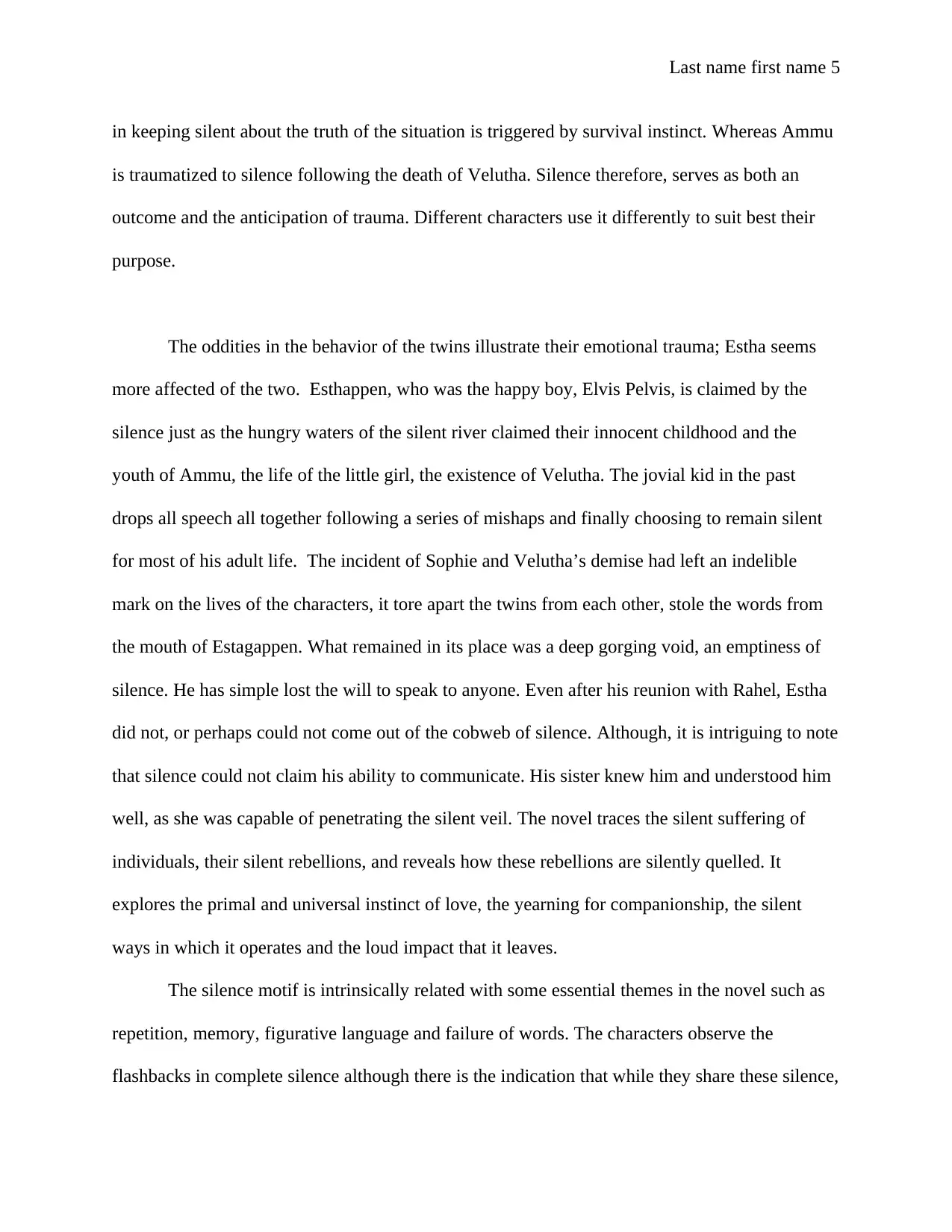
Last name first name 5
in keeping silent about the truth of the situation is triggered by survival instinct. Whereas Ammu
is traumatized to silence following the death of Velutha. Silence therefore, serves as both an
outcome and the anticipation of trauma. Different characters use it differently to suit best their
purpose.
The oddities in the behavior of the twins illustrate their emotional trauma; Estha seems
more affected of the two. Esthappen, who was the happy boy, Elvis Pelvis, is claimed by the
silence just as the hungry waters of the silent river claimed their innocent childhood and the
youth of Ammu, the life of the little girl, the existence of Velutha. The jovial kid in the past
drops all speech all together following a series of mishaps and finally choosing to remain silent
for most of his adult life. The incident of Sophie and Velutha’s demise had left an indelible
mark on the lives of the characters, it tore apart the twins from each other, stole the words from
the mouth of Estagappen. What remained in its place was a deep gorging void, an emptiness of
silence. He has simple lost the will to speak to anyone. Even after his reunion with Rahel, Estha
did not, or perhaps could not come out of the cobweb of silence. Although, it is intriguing to note
that silence could not claim his ability to communicate. His sister knew him and understood him
well, as she was capable of penetrating the silent veil. The novel traces the silent suffering of
individuals, their silent rebellions, and reveals how these rebellions are silently quelled. It
explores the primal and universal instinct of love, the yearning for companionship, the silent
ways in which it operates and the loud impact that it leaves.
The silence motif is intrinsically related with some essential themes in the novel such as
repetition, memory, figurative language and failure of words. The characters observe the
flashbacks in complete silence although there is the indication that while they share these silence,
in keeping silent about the truth of the situation is triggered by survival instinct. Whereas Ammu
is traumatized to silence following the death of Velutha. Silence therefore, serves as both an
outcome and the anticipation of trauma. Different characters use it differently to suit best their
purpose.
The oddities in the behavior of the twins illustrate their emotional trauma; Estha seems
more affected of the two. Esthappen, who was the happy boy, Elvis Pelvis, is claimed by the
silence just as the hungry waters of the silent river claimed their innocent childhood and the
youth of Ammu, the life of the little girl, the existence of Velutha. The jovial kid in the past
drops all speech all together following a series of mishaps and finally choosing to remain silent
for most of his adult life. The incident of Sophie and Velutha’s demise had left an indelible
mark on the lives of the characters, it tore apart the twins from each other, stole the words from
the mouth of Estagappen. What remained in its place was a deep gorging void, an emptiness of
silence. He has simple lost the will to speak to anyone. Even after his reunion with Rahel, Estha
did not, or perhaps could not come out of the cobweb of silence. Although, it is intriguing to note
that silence could not claim his ability to communicate. His sister knew him and understood him
well, as she was capable of penetrating the silent veil. The novel traces the silent suffering of
individuals, their silent rebellions, and reveals how these rebellions are silently quelled. It
explores the primal and universal instinct of love, the yearning for companionship, the silent
ways in which it operates and the loud impact that it leaves.
The silence motif is intrinsically related with some essential themes in the novel such as
repetition, memory, figurative language and failure of words. The characters observe the
flashbacks in complete silence although there is the indication that while they share these silence,
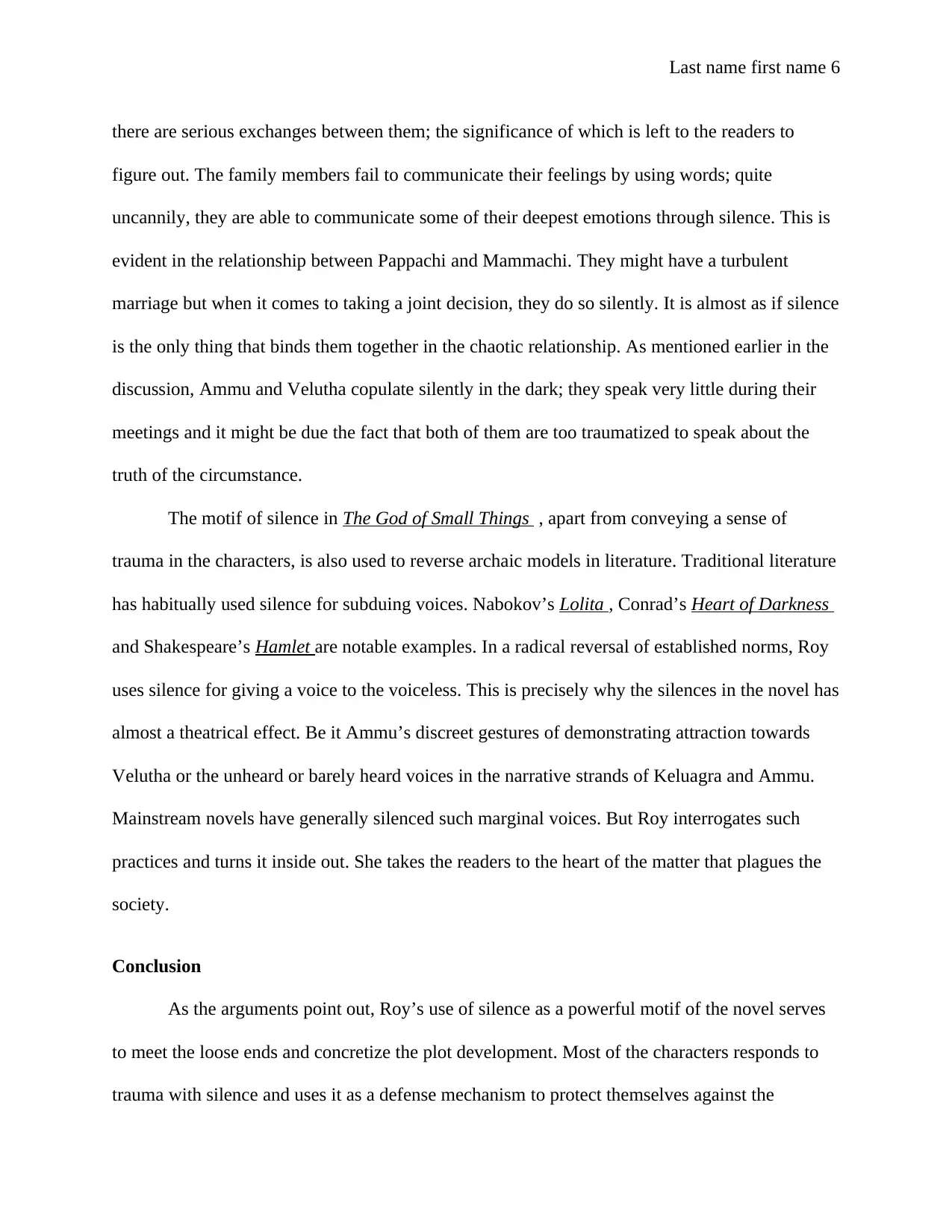
Last name first name 6
there are serious exchanges between them; the significance of which is left to the readers to
figure out. The family members fail to communicate their feelings by using words; quite
uncannily, they are able to communicate some of their deepest emotions through silence. This is
evident in the relationship between Pappachi and Mammachi. They might have a turbulent
marriage but when it comes to taking a joint decision, they do so silently. It is almost as if silence
is the only thing that binds them together in the chaotic relationship. As mentioned earlier in the
discussion, Ammu and Velutha copulate silently in the dark; they speak very little during their
meetings and it might be due the fact that both of them are too traumatized to speak about the
truth of the circumstance.
The motif of silence in The God of Small Things , apart from conveying a sense of
trauma in the characters, is also used to reverse archaic models in literature. Traditional literature
has habitually used silence for subduing voices. Nabokov’s Lolita , Conrad’s Heart of Darkness
and Shakespeare’s Hamlet are notable examples. In a radical reversal of established norms, Roy
uses silence for giving a voice to the voiceless. This is precisely why the silences in the novel has
almost a theatrical effect. Be it Ammu’s discreet gestures of demonstrating attraction towards
Velutha or the unheard or barely heard voices in the narrative strands of Keluagra and Ammu.
Mainstream novels have generally silenced such marginal voices. But Roy interrogates such
practices and turns it inside out. She takes the readers to the heart of the matter that plagues the
society.
Conclusion
As the arguments point out, Roy’s use of silence as a powerful motif of the novel serves
to meet the loose ends and concretize the plot development. Most of the characters responds to
trauma with silence and uses it as a defense mechanism to protect themselves against the
there are serious exchanges between them; the significance of which is left to the readers to
figure out. The family members fail to communicate their feelings by using words; quite
uncannily, they are able to communicate some of their deepest emotions through silence. This is
evident in the relationship between Pappachi and Mammachi. They might have a turbulent
marriage but when it comes to taking a joint decision, they do so silently. It is almost as if silence
is the only thing that binds them together in the chaotic relationship. As mentioned earlier in the
discussion, Ammu and Velutha copulate silently in the dark; they speak very little during their
meetings and it might be due the fact that both of them are too traumatized to speak about the
truth of the circumstance.
The motif of silence in The God of Small Things , apart from conveying a sense of
trauma in the characters, is also used to reverse archaic models in literature. Traditional literature
has habitually used silence for subduing voices. Nabokov’s Lolita , Conrad’s Heart of Darkness
and Shakespeare’s Hamlet are notable examples. In a radical reversal of established norms, Roy
uses silence for giving a voice to the voiceless. This is precisely why the silences in the novel has
almost a theatrical effect. Be it Ammu’s discreet gestures of demonstrating attraction towards
Velutha or the unheard or barely heard voices in the narrative strands of Keluagra and Ammu.
Mainstream novels have generally silenced such marginal voices. But Roy interrogates such
practices and turns it inside out. She takes the readers to the heart of the matter that plagues the
society.
Conclusion
As the arguments point out, Roy’s use of silence as a powerful motif of the novel serves
to meet the loose ends and concretize the plot development. Most of the characters responds to
trauma with silence and uses it as a defense mechanism to protect themselves against the

Last name first name 7
pandemonium that is the world. Arundhuti Roy tactfully employs the motif of silence to convey
the things that words fail to communicate. The story, like silence, does not have any definite
meaning, it appeals to different readers in different ways, depending on their perspectives of life
and society. Even in the film adaptation of the book, the motif of silence comes across
powerfully with the deliberated pauses in scenes and the characters communicating more in
gestures than in words. Moreover, the motif of silence aptly conveys the intensity of the trauma,
the burden of which must be borne out by all the central characters of the novel. When all
expressions fail, they have silence to fall back on for communicating the inexplicable. Since the
anxiety of trauma is difficult to convey in words, the novel uses silence to give an expression to
the traumatic experiences of the characters.
pandemonium that is the world. Arundhuti Roy tactfully employs the motif of silence to convey
the things that words fail to communicate. The story, like silence, does not have any definite
meaning, it appeals to different readers in different ways, depending on their perspectives of life
and society. Even in the film adaptation of the book, the motif of silence comes across
powerfully with the deliberated pauses in scenes and the characters communicating more in
gestures than in words. Moreover, the motif of silence aptly conveys the intensity of the trauma,
the burden of which must be borne out by all the central characters of the novel. When all
expressions fail, they have silence to fall back on for communicating the inexplicable. Since the
anxiety of trauma is difficult to convey in words, the novel uses silence to give an expression to
the traumatic experiences of the characters.
Paraphrase This Document
Need a fresh take? Get an instant paraphrase of this document with our AI Paraphraser

Last name first name 8
Bibliography:
Roy, Arundhati. The god of small things (1997). na, 2002.
Bibliography:
Roy, Arundhati. The god of small things (1997). na, 2002.
1 out of 8
Your All-in-One AI-Powered Toolkit for Academic Success.
+13062052269
info@desklib.com
Available 24*7 on WhatsApp / Email
![[object Object]](/_next/static/media/star-bottom.7253800d.svg)
Unlock your academic potential
© 2024 | Zucol Services PVT LTD | All rights reserved.
